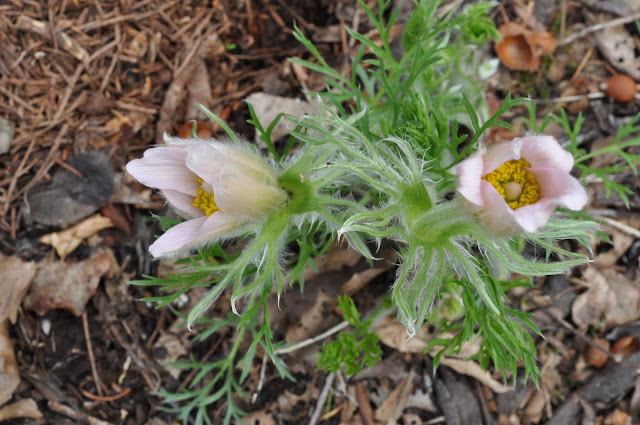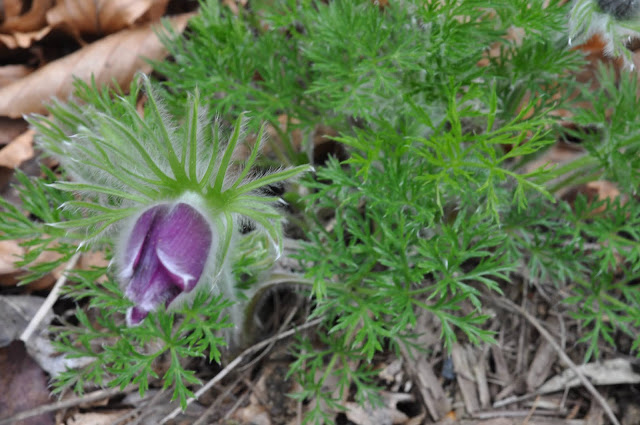Pulsatilla
Pasque-Flowers.
A small genus of plants closely related to Anemone and only recently separated from them. 30 species of tufted hardy perennials and only 21 permitted into Australia. I have done the weed risk assessments about 3-4 years ago, but no word as yet from Bicon.
A sign that spring has come when the goblet shaped flowers of the Pulsatilla's show their nodding flowers, pushing through their hairy fern like leaves. Pulsatilla's need a deep soil that does not dry out and and they need to be watered in our summer months. They do not like to be moved once established or divided or you will loose the whole plant, divisions and all, they are best propagated by seed that germinates reasonably well.
Whilst staying in the Cotswolds in the UK. we found our hosts at a B&B were the keepers of the Pulsatilla vulgaris some of their paddocks were covered in Pulsatilla's, they were not allowed to plow, put animals into those paddocks (or field's in the UK) at all, or cut the hay until the Pulsatilla vulgaris had shed their seed. They were very proud that they had Pulsatilla on their land as the pasque-flower is rarely seen in the UK now.
Pulsatilla vulgaris in the UK is sometimes found on the edges of Roman roads and protected Roman historical sites, it is said that the richly coloured flowers grew from the blood of invading Danes and Romans. The buds of Pulsatilla vulgaris emerge in late winter and early spring covered in silky hairs, catching the rain drops or moisture in the air, as below.
Pulsatilla albana Albo-cyrnea from Caucases above and below, with finely dissected foliage.
Pulsatilla albana subsp. flavescens.
Pulsatilla alpina subsp. apifolia above, at the top of Picos de Europa. It was very cold and blowing a gale, and before we knew it there was lightning, thunder and then hail, followed by snow all in 5-6 minutes and when you are the tallest thing on the top of a mountain its time to run. The blue flowers are Lithodora diffusa growing in a small crevice.
A seed head of a Pulsatilla at the top of Picos de Europa, foliage of Pulsatilla vernalis below and a flower head nestled down in the foliage, could the seed head above belong to this foliage. My plant died at the hands of summer, just didn't like the heat and didn't flower, but I will try again to grow this beautiful plant.
Not my photo below but I needed to show you how beautiful the flowers are and why I need to keep trying to grow Pulsatilla vernalis from Europe and Siberia. The Encyclopaedia of Alpines by the AGS UK says to grow in the Alpine House, too hot in Australia, raised beds, radiated heat in Australia or scree bed that might work, as long as it is situated in a cool position. For 3 seasons of the year I find we can grow things beautifully, come summer its dreadful to see your best efforts destroyed. But we pick ourselves up and start again.
Pulsatilla aff. campanella Peter Erskin, Vale Cottage Garden. This plant with yellow flowers inside with a very dark exterior covered in fine hairs is from Tien Shan, Ala Archa valley south of Bishkek, Kyrgyzstan, may need more research say's Christopher Grey-Wilson, and be a distinct taxon. Below is the form I used to grow Pulsatilla slavica ex USSR this is scanned from an old slide, just shows how lucky we are with digital photography today.
Pulsatilla ambigua above and below, Anemone nemorosa in back ground makes a gentle ground cover for a lot of the plants and bulbs that I grow. It is quite easy to plant in and amongst the twiggy roots of the Anemone and they never seem to smother the other plants. Pulsatilla ambigua flowers are covered in fine silky hairs on the out side, flowers are usually violet-blue, rarely pink or purplish red, lucky mine are pink. From Russia eastwards to China and Mongolia 2,000 to 3,400m. Rocky Mountain meadows and forest margins.
Pulsatilla subsp. Hungarica syn. P. flavescence Holubeck seed Cyril Lafong's glass house.
Pulsatilla aurea syn. P. sulphurea Jack Drakes Nursery Scotland.
Pulsatilla georgica Cyril Lafong's garden, nodding bells covered in hairs a gorgeous plant. Its habitat is open grassy meadows in woodland in Georgian Caucasus and North East Turkey. This species is not allowed into Australia, it is not on Bicon, if anyone would like to do a weed risk assessment to jog Bicon's memory I would be very grateful.
Pulsatilla halleri subsp. slavica the flowers open before the leaves fully open, stems and flower tips are covered in hairs almost snow white, there are forms covered in golden brown hairs, but I haven't seen any of these forms. These buds were opening today and I thought they were both so beautiful I just had to show you both photos, these flower stems will eventually get to about 30-40cm. This Pulsatilla is growing in an open fairly sunny position, receiving some shade in the summer months, in a very deep soil.
Pulsatilla halleri subsp. slavica from the Carpathians SRG seed from 2015 above and two below. Each subsp. of P. halleri coming from different areas of Europe has differing primary leaf divisions.
Pulsatilla halleri subsp. slavica above with a beautiful boss of stamens.
The plants of all the Pulsatilla have beautiful seed heads and when you touch them and they come away in your fingers they are ready to harvest. Store seed in a cool position in brown paper bags until dry and then place in refrigerator in a sealed container in the fridge.
Pulsatilla grandis Budapest Blue above and below. Exhibited at an Alpine Garden Society show in UK in 1963 by Valerie Finnis, had Ice blue flowers, enveloped in golden silky hairs. Mine is a nice blue, but comes nowhere near that description.
Pulsatilla pratensis nigricans buds emerging through ferny foliage.
Some of the darkest flowers found in Pulsatilla are in the genus belonging to P. pratensis, particularly in subsp. nigricans. The dark nodding bell shaped flowering stems get to 10 to 15cm high, and can be almost black to greenish yellow. They are found growing up in the high meadows of Central Europe mainly in grassland (above and below)

Pulsatilla grandis Papageno come in a wide variety of colours with the exception of green and yellow,
they are easy from seed and commercial seed sellers jelitto.com and alplains.com you need to let Alan from Alplains Seed know, we do not need a phytosanitary certificate for seed to Australia, but check Bicon first, as not all Pulsatilla seed are allowed in as yet.
Gentiana Nursery and Antique Perennials sell plants of Pulsatilla, contact them first before you bring in seed, as they may have already done the importing for you.
Pulsatilla zimmermannii SRG seed 2/2015 above and below has had a few name changes. It is endemic to north and central Hungary and the adjacent regions. According to Christopher Grey-Wilson it needs further research. Pulsatilla's do not like over hanging foliage or plants growing on top of them they need a space all to themselves.
New foliage of Pulsatilla montana breaking through the soil covered in hairs SRG 2/2015.
Pulsatilla montana is very closely related to P. pratense but the flower shape and size P. montana flower is much larger and when flowers open up they are flatter. The perianth segments twice the length of the stamens, flowers are deep bluish violet. Found growing in meadows and forest up to 2,150m of central and eastern Europe.

This beautiful Pulsatilla was growing in Ian and Ann Christie's glass house in Scotland, Ian thought it was either P. campanella or P. album hybrid.
The only book I know of that specialises in Pulsatilla is by Christopher Grey-Wilson. At first there were only 300 copies printed, they are numbered mine is signed and numbered 281. I noticed with the last AGS UK Journal there must have been a reprint because it was listed for sale again, in the book sale pages. A good reference on Pulsatilla. I find seed from the seed exchanges are all a bit mixed up, you're never quite sure what you are going to get, but generally speaking they are pretty good.
I hope this article will encourage you to grow at least one Pulsatilla from seed, and this article will help you to grow some. I have only grown some of the easier forms, but there are many for you to try.




































1 comment:
My interest is wild alpine flowers of the Victorian High Plains (Australia). How to protect them and enjoy them in situ over the summer season. Anyone out there who has the same interest is welcome to contact me at meg.benalla@gmail.com Thanks for informative articles on some of the species
Com
Post a Comment